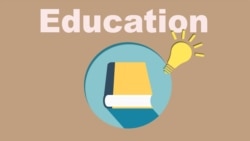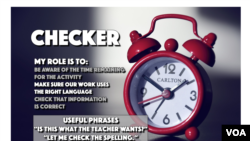Two heads are better than one.
Or so the expression goes. It means that two people working together have a better chance of solving a problem than one person alone. But not everyone likes working with others – especially when that means working in a group.
There can be a number of reasons why people dislike group work. Some may feel nervous or uneasy in group situations. Others might have had a bad experience with individuals who did not work well as a team.
Another criticism is that teachers or supervisors fail to assign roles to group members. This may create a situation where everyone or no one wants to lead.
Whatever the issue, the result is the same: the group does not realize its goal.
Cooperative learning is an educational method that can help to solve this problem.
There are many methods of cooperative learning. Today we will talk about one: giving each person in a small group a specific duty to reach a shared goal. For example, if learners are divided into groups of four people each, their roles might be: leader, writer, checker and speaker.
This structure helps ensure that everyone takes part equally in group work. It also allows each member to play a meaningful part in completing the shared goal.
Retired educator Michelle Manville has written several books about education and learning standards. Many of her books note that cooperative learning creates a supportive group structure and lessens the problem of competitiveness.
Studies have also shown that cooperative learning improves learner achievement. This includes one study by American researcher Robert Slavin.*
Cooperative learning in non-class settings
The method we are talking about today can be used in a number of educational settings, both structured and informal.
Teachers may use it in a classroom. But the method is also useful in other situations. Companies, for instance, may use it as they train employees in team-building and other exercises.
Organizations for English learners, such as English clubs, can also achieve a lot from this method. Such groups meet in any number of places – at restaurants, coffee houses, in classrooms and even at people's homes. Cooperative learning can be used in all of these situations.
For example, imagine that the head of an English club divides club members into small groups. Each group is told to come up with directions for making a specialty food. Your group chooses pizza.
Before you begin, the "leader" makes sure everyone understands the activity and their responsibilities. During the activity, that person also makes sure the group stays focused on the work to be done.
The group identifies the materials needed for making the pizza and also talks about how to prepare it. As this happens, the "recorder" writes down the step-by-step directions. At the same time, the "checker" can look up words to make sure the group is choosing the right language. When the work is complete, the "speaker" shares your group's pizza recipe with the other people in the club.
Preparing for an activity
Before dividing learners into groups, it is a good idea for the teacher or club’s supervisor to first have knowledge about the language skill levels of participants. The goal is to make each group a mixture of higher- and lower-level language learners. Putting too many people with similar skill levels together could make the work too difficult or easy.
Role cards can be a helpful tool in this method of cooperative learning. The reusable paper cards have notes describing the role of each person. Their purpose is to remind learners of each person’s role. The cards can be placed on a table or on desks.
You can download role cards from the VOA Learning English website and print them onto card stock or regular paper.
(Click here to download the role cards.)
Before, during and after the activity
Before the cooperative activity, the role of the teacher or activity supervisor is make sure to explain two things to the group: the main task for the activity and how the cooperative roles work. The person in charge may appoint these roles or let the English learners choose them.
Then, during the activity, the supervisor's job is to watch the groups and provide more guidance when needed.
After the activity, the supervisor may wish to provide feedback to groups on their work and their use of cooperation.
Hearing friends or classmates speak about their group's work gives everyone a chance to listen to other learners speaking English. Learners can also gain a lot from seeing how others in their club or class complete language tasks and from hearing different perspectives.
With this cooperative learning method, you could say that four heads are better than just one.
Visit learningenglish.voanews.com for examples of this method in Units 2 and 6 of the video-based training course Let's Teach English.
I'm Bruce Alpert. And I'm Alice Bryant.
Alice Bryant wrote this story for Learning English. George Grow was the editor.
Have you used a cooperative learning method in an English club, classroom, company or somewhere else? Did you enjoy it? What did you learn from it? Write to us in the comments section.
*Finding from Robert Slavin's paper "Cooperative learning and the cooperative school"
_______________________________________________________________
Words in This Story
assign – v. to give someone a particular job or duty
standard – n. a level of quality or achievement that is required or considered acceptable or desirable
informal – adj. having a friendly and relaxed quality
remind – v. to cause someone to remember something
desk – n. a piece of furniture that is like a table for one person
card stock – n. a paper stock that is thicker than normal writing/printing paper
task – n. a piece of work that has been given to someone
feedback – n. helpful information or criticism that is given to someone to say what can be done to improve something
perspective – n. a way of thinking about and understanding something
focus – v. to cause attention to be directed at something specific
|
Leader |
Makes sure everyone understands the activity before the group begins working. Makes sure the group stays focused and members actively take part. Useful phrases include, "Does everyone understand their role?" "Let's start by doing…." and "Let's stay on the task we have to complete." |
|
Writer / Recorder |
Writes down important information from the task. They also write down the ideas for the speaker to present. Useful phrases include, "Can you say that again, please?" "How shall I write this?" and "Have I written this clearly?" |
|
Checker |
Makes sure that information and language the group uses for the work is correct. Also stays aware of the time remaining for the activity. Useful phrases include, "Is this what the teacher/manager wants?" "Let me check the spelling/meaning of that word" and "We have five minutes left." |
|
Speaker |
Summarizes the group's work for the rest of the club or class. Useful phrases include, "Shall I start with….?" and "How does this sound?" |











